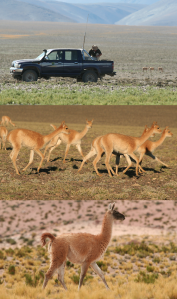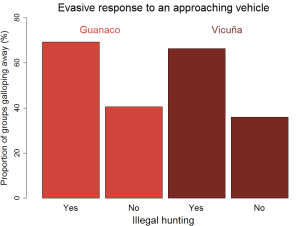
Study vehicle, a group of vicuñas and a guanaco in San Guillermo National Park (San Juan, Argentina) [courtesy of Marco Escudero]. Guanacos and vicuñas are native to South America, and are the ancestors of domesticated llamas and alpacas – which are exploited for their meat, milk and wool. Both species form monotypic genera. They have discontinuous distributions in Argentina, Bolivia, Chile and Peru, with introduced populations in Paraguay (guanaco) and Ecuador (vicuña). Population estimates are > 500,000 (guanaco) and > 300,000 (vicuña), the latter restricted to high-altitude ecosystems. They are ‘Least Concern’ for the IUCN but, given their low population growth rates (fertility = 1 offspring/female/yr), guanacos and vicuñas are targeted by conservation programs in all their native countries.
Many of us might have stumbled twice on the same stone, yet learnt to be wary of future situations of similar risk. Likewise, wild animals can be predisposed to flee when faced with already known predators (or threats in general). The type and magnitude of their evasive response depends on predator distance, speed and body size (1). Regardless, prey need to assess predation risk in a matter of seconds (or even shorter than that), i.e., balancing the benefits and costs of fleeing.
The benefits all boil down to survival, but the costs might include moving away from offspring, loss of access to fresh and abundant food, or spending precious metabolic energy (2). The methods ecologists use to study animal flight behaviour in the wild are rife with nuisances (3), yet they represent a tool for quantifying wildlife stress resulting from a variety of human activities.
Equipped with our modern technological kit (weapons, vehicles, GPS, etc.), humans behave like genuine predators and can trigger the range of flight behaviours displayed by their potential prey. In that context, Emiliano Donadio and Steve Burskirk (4) studied flight behaviour of guanacos (Lama guanicoe) and vicuñas (Vicugna vicugna) in the Argentinean open plains (‘llanos’). They monitored 2 protected areas under weak surveillance and subject to illegal hunting: the Laguna Brava Provincial Reserve and the San Guillermo Biosphere Reserve (treatment = H); and one area free of hunting and only exposed to guided visits with strict entry/exit times: the San Guillermo National Park (treatment = NH). The ecologists did 3 transects per study area. When they encountered a group of camelids, they classified three types of flight behaviour (alert without fleeing, walking away, galloping away), and measured flight time (between vehicle detection and initiation of flight behaviour) and flight distance (between the vehicle and the individuals when initiating flight behaviour).

Percentage of guanaco and vicuña groups showing the strongest evasive response to an approaching vehicle in protected areas exposed to and free of hunting in the Argentinean llanos from Catamarca, La Rioja, San Juan and Mendoza provinces (4). The study totaled 540 km (9 transects in winter between 09.00 and 16.00) and used a vehicle running at 20-35 km/h along dirt roads not visited by tourists. The histogram shows that galloping away was 30% more frequent in hunted areas for both species.
In total, they surveyed 234 groups of vicuñas and 65 of guanacos, with conclusive results. Galloping away occurred for 70% of the groups in H and 40% in NH. Median flight time was 1 second in H, and 15 (guanaco) to 27 (vicuña) seconds in NH. Median flight distance also varied between 400 (guanaco) and 1000 (vicuña) metres in H, and stayed at ~300 m in NH. Those trends remained across groups whether or not juveniles were present, and despite the fact that pumas (Puma concolor) – the main natural predator of both ungulates (5, 6) – were more abundant in NH. Other studies report guanaco habituation to traffic and tourists (but exempt of aggression) (7, 8) and responses to predators in tall/dense vegetation and undulating land was weaker than in low/sparse vegetation and flat land (9).
Protected areas work, but only when you put in the effort (10). Donadio and Buskirk (4) provide indirect evidence for weak investment into preventing hunting of South American camelids in well-established protected areas. They postulate that pervasive hunting can displace guanacos and vicuñas to low-quality habitats, and point out that the problem might worsen if the expanding mining industry opens new roads reaching the most remote areas of the llanos.
References
- Stankowich, T. & Blumstein, D. T. (2005). Fear in animals: a meta-analysis and review of risk assessment. Proceedings of the Royal Society B-Biological Sciences, 272: 2627-2634
- Cooper, W. E., Jr. (2009). Fleeing and hiding under simultaneous risks and costs. Behavioral Ecology, 20: 665-671
- Dumont, F. et al. (2012). Flight initiation distance and starting distance: biological effect or mathematical artefact? Ethology, 118: 1051-1062
- Donadio, E. & Buskirk, S. W. (2006). Flight behavior in guanacos and vicunas in areas with and without poaching in western Argentina. Biological Conservation, 127: 139-145
- Donadio, E. et al. (2010). Evaluating a potentially strong trophic interaction: pumas and wild camelids in protected areas of Argentina. Journal of Zoology, 280: 33-40
- Zanón-Martínez, J. I. et al. (2012). The ecological role of native and introduced species in the diet of the puma Puma concolor in southern Patagonia. Oryx, 46: 106-111
- Malo, J. E. et al. (2011). Measuring ungulate tolerance to human with flight distance: a reliable visitor management tool? Biodiversity and Conservation, 20: 3477-3488
- Marino, A. & Johnson, A. (2012). Behavioural response of free-ranging guanacos (Lama guanicoe) to land-use change: habituation to motorised vehicles in a recently created reserve. Wildlife Research, 39: 503-511
- Taraborelli, P. et al. (2012). Cooperative vigilance: the guanaco’s (Lama guanicoe) key antipredator mechanism. Behavioural Processes, 91: 82-89
- Laurance, W. F. et al. (2012). Averting biodiversity collapse in tropical forest protected areas. Nature, 489: 290-294

